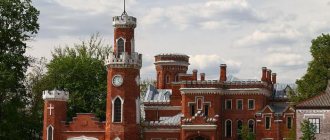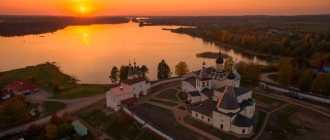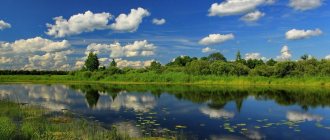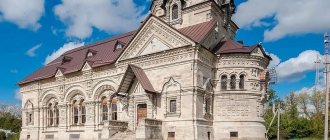Oryol region is considered one of the smallest. It was formed in 1937 and is part of the Central Federal District. Consists of twenty-four municipal districts. The total population for 2022 is 733,682. The regional center is the city of Orel, located in the south, 410 kilometers from Moscow.
Trinity Nativity of the Virgin Mary Optin Monastery, Bolkhov
What holiday is it today?
February 10, 2022, Thursday
Today are holidays, events: Diplomat's Day Tomorrow: World Sick Day Discovery of insulin
Today is the Orthodox holiday: St. Ephraim the Syrian. Venerable Ephraim of Novotorzhsky. Venerable Ephraim of Pechersk, Bishop of Pereyaslavl. Venerable Theodosius of Totem, Spasosumorin of the monastery, leader and founder... Tomorrow: Transfer of the relics of the holy martyr Ignatius the God-Bearer. Saints Gerasim, Pitirim, Jonah, bishops of Great Perm, Ustva...
Today is a national holiday: Ephraim's Day... Tomorrow: Lawrence's Day
Seasons
Seasons, four periods of the year (spring, summer, autumn and winter) characterized by certain average temperatures. The period during which the Sun passes through one of these sectors is called the season. Spring in the Northern Hemisphere and autumn in the Southern Hemisphere begin when the Sun passes through the initial circle of declination and its right ascension is 0° (vernal equinox). Summer in the Northern Hemisphere and winter in the Southern Hemisphere occur when the sun's right ascension is 90° (summer solstice). Autumn in the Northern Hemisphere and spring in the Southern Hemisphere begin when the sun's right ascension is 180° (autumnal equinox). The beginning of winter in the Northern Hemisphere and summer in the Southern Hemisphere is considered to be the winter solstice, when the direct ascension of the Sun is 270°... Next: Seasons. Russian folk calendar. Monthly words...
see also
- Oryol Region
- Cities of Russia
| [ + ] Cities by regions of Russia | |
| Cities of the North-West (NWFD) | St. Petersburg (and its cities) • Leningrad region (historical Staraya Ladoga) • Arkhangelsk region • Vologda region • Kaliningrad region • Karelia • Komi • Murmansk region • Nenets Autonomous Okrug • Pskov region |
| Cities of the Volga region (Volga Federal District) | Bashkortostan • Volgograd region • Kalmykia • Kirov region • Mari El • Mordovia • Nizhny Novgorod region • Orenburg region • Penza region • Perm region • Samara region • Saratov region • Tatarstan • Udmurtia • Ulyanovsk region • Chuvashia |
| Cities of Southern Russia (SFD) | Sevastopol (including Inkerman) • Republic of Crimea • Adygea • Astrakhan region • Krasnodar region • Rostov region |
| Cities of the North Caucasus (NCFD) | Dagestan • Ingushetia • Kabardino-Balkaria • Karachay-Cherkessia • North Ossetia - Alania • Stavropol Territory • Chechen Republic |
| Cities of the Urals (Ural Federal District) | Kurgan region • Sverdlovsk region • Tyumen region • Khanty-Mansi Autonomous Okrug - Yugra • Chelyabinsk region • Yamalo-Nenets Autonomous Okrug |
| Cities of Siberia (Siberian Federal District) | Altai Republic • Altai Territory • Irkutsk Region • Kemerovo Region • Krasnoyarsk Region • Novgorod Region • Novosibirsk Region • Omsk Region • Tomsk Region • Tyva • Khakassia |
| Cities of the Far East (FEFD) | Amur Region • Buryatia • Jewish Autonomous Region • Trans-Baikal Territory • Kamchatka Territory • Magadan Region • Primorsky Territory • Sakha (Yakutia) • Sakhalin Region • Khabarovsk Territory • Chukotka Autonomous Region |
| see also | Cities of the DPR, LPR, Transnistria, South Ossetia • Regions of Russia • Cities of Russia |
Folk calendar about every day
Every day one season always replaces another and this determines a person’s way of life. In connection with this, a folk calendar was formed in which there were practically no nameless, unmarked days. Every day was special, had its own purpose. All this was determined by climate conditions and astrological phenomena.
A calendar is a system for counting periods of time. The first calendars arose a long time ago, in ancient times, because there was a need to measure time. The word calendar comes from the Latin words caleo - to proclaim and calendarium - debt book. This is due to the fact that in Ancient Rome the beginning of each month was especially proclaimed, and because it was customary to pay debts on the first day of the month. Different peoples counted time differently. Some calendars are based on the changing phases of the moon - lunar calendars; in others - the change of seasons - sunny; in others, the length of the year was coordinated with the change of seasons, and the counting of months was associated with the phases of the Moon. Such calendars are called lunisolar.
In Rus', the calendar was called a monthly calendar. Every day, the month book covered the entire year of peasant life, “describing” day by day, month after month, where each day had its own holidays or weekdays, customs and superstitions, traditions and rituals, natural signs and phenomena. The cyclical nature of the calendar is reminiscent of human life, where spring is youth, summer is heyday, autumn is the time of harvesting fruits (it’s good if there are some, otherwise you can live your life without collecting fruits), winter is the time of wisdom and peace. This cyclicality and rhythm determined the way of life of the farmer. The folk calendar was an agricultural calendar, which was reflected in the names of the months, folk signs, rituals and customs. Even the determination of the timing and duration of the seasons is associated with real climatic conditions. Hence the discrepancy between the names of the months in different areas... Next: Folk calendar...
Architectural and historical monuments
The city has preserved architectural monuments of the 17th and 18th centuries: the buildings of the Peter and Paul Monastery, founded in the 16th century. and moved to its present site in 1694; Church of the Intercession (turn of the 17th-18th centuries); Church of the Sign (1813-1821). On the almost vertical bank of the Zushi River is the Vvedenskaya Church (originally - Peter and Paul), which was the cathedral of the Peter and Paul Monastery. On the shore, near the Moscow-Simferopol highway, there is the Church of the Ascension (late 17th century), which was badly damaged as a result of the reconstruction of 1950-1952. Near the bridge over Zusha there is another Church of the Ascension, built in 1832, with a bell tower from the second quarter of the 19th century. On the right bank of the Zushi, one of the best monuments of classicism in the Oryol region has been preserved - the Church of Nikita (1810-1818), within the walls of which the body of Emperor Alexander I was located on January 23-25, 1826 on the way from Taganrog to St. Petersburg. The Trinity Church (1777) is also located here.
Mtsensk and Mtsensk district are glorified by the names of many famous people. 7 km from Mtsensk, in the village of Novoselki, the poet A. A. Fet was born. Natives of the Mtsensk district are composer V. S. Kalinnikov, teacher A. P. Kiselev. Mtsensk became especially famous thanks to N. S. Leskov , the author of the story “Lady Macbeth of Mtsensk”. The museum-estate of I. S. Turgenev Spasskoye-Lutovinovo is located 10 km from Mtsensk.
Fishing calendar for every day
The fishing calendar should not be taken as an absolutely indisputable truth. Fish biting is greatly influenced by a whole range of natural factors, as well as the influence on the nature of man himself. You must not forget that the fish’s bite depends and is determined not only by the calendar dates and biological cycles of their life, reflected in the calendar, but also, no less, by the state of their habitat; the bite also depends on weather conditions: air and water temperatures, cloudiness, wind direction and strength, etc... Next: Fishing calendar...
Novosil
Novosil , a regional center in the Oryol region, 80 km east of Oryol. Located within the Central Russian Upland, on the river. Zusha (tributary of the Oka), 16 km from the Zalegoshch railway station on the Orel - Yelets line. Airport. Population 4.5 thousand people (1992; 2.9 thousand in 1897; 2.7 thousand in 1926; 3.1 thousand in 1979). Known since 1155 as a city of the Chernigov principality. At the beginning of the 14th century. center of the appanage Novosilsk principality; at the beginning of the 15th century. went to Lithuania, from the end of the 15th century. again as part of the Moscow state. In the 16th century entered the Zasechnaya line. Since 1777 - a district town in the Tula province. By the end of the 19th century. In Nizhny there were 7 small enterprises, mainly processing agricultural raw materials. During the Great Patriotic War of 1941-45 it was occupied by Nazi troops on November 13, 1941; liberated on December 27, 1941. Modern Nizhny Novgorod is the center of an agricultural region (grain farming, potato growing, meat and dairy farming). Enterprises for processing agricultural products.
Orthodox calendar about every day
Orthodox calendar: Orthodox, Church and Christian holidays.
The church year is an alternation of weekdays and holidays. On weekdays, a person is called to work “by the sweat of his brow to earn his bread.” Holidays are given in order to feel liberation, to rise above the bustle and routine of the world, to feel involved in the highest of worlds, “where there are no illnesses, sorrows and sighs, but endless life.” Since ancient times, holiday cycles have been associated with the seasons. The pagans associated them with the worship of the forces of nature, the cult of which in the Old Testament was replaced by gratitude to the Creator for the universe. And although the connection between holidays and the seasons has not completely lost its power, since God is present in everything, in the plant and animal world, in human works, it nevertheless faded into the background, giving way to a spiritual foundation built on the Sacred Scriptures. The history of Orthodox holidays dates back to the times of the Old Testament. Each of the Orthodox holidays is dedicated to the remembrance of the most important events in the life of Jesus Christ and the Mother of God, as well as the memory of saints... Next: Orthodox calendar...
Story
Mtsensk is the oldest city in the Oryol region. It was first mentioned in the Ipatiev Chronicle in 1146 under the name “Michensk” as part of the Chernigov principality. The city was a military fortress and trade and craft center of the Verkhneoksky settlement. In 1238 it was destroyed by Batu, in 1320-1504. was under Lithuanian rule. After joining the Moscow Principality, fortifications were strengthened here, in the 16-17 centuries. The Mtsensk fortress was one of the largest in the south of the Russian state. In the 17th-19th centuries. Trade, handicrafts and crafts actively developed in the city, and the Mtsensk grain pier became famous. At the end of the 19th century. Mtsensk was famous for weaving lace, which was supplied to the imperial court and exported to England and Turkey. During the Great Patriotic War, the city was occupied and severely destroyed during the fighting on the Kursk-Oryol Bulge.
There is a city history museum in Mtsensk.
Russian folk calendar for every day
The word “sign” comes from the word “notice”, i.e. observe. As a result of observing what happens around a person every day, he accumulates life experience. This knowledge was passed down from generation to generation, carefully preserved and people trusted it as a sacred book. Many signs have come to us from the depths of centuries without losing their knowledge. Each of us is free to choose: to dismiss all this as an absurd superstition or to take a closer look at the signs and take the centuries-old experience of generations more seriously. Most of us, when taking exams, ask them to scold them, boasting about some kind of good fortune or luck, spit so as not to jinx them or knock on wood, take a detour if a black cat crossed the road, are afraid of the number 13 and much more. And who among us does not have lucky things, numbers? Who has never resorted to the help of fate at least once in their life, who has not believed in secrets? It’s as if everything connected with signs is hidden somewhere deep in our subconscious. Often we remember them mechanically, unconsciously, or just as a joke. But, undoubtedly, the signs contain a lot of accurate knowledge and practical wisdom of our ancestors. They cover all the characteristic, often difficult to perceive, natural phenomena. Signs have preserved a lot of what was in old folk holidays and customs; they help predict the weather, grow crops... Next: Folk signs...
Cities[ | ]
| № | Name | district / city of regional significance | population (persons) | area (km²) | founding/first mention | city status | former names | coat of arms |
| 1 | Bolkhov | Bolkhovsky district | ↘10 685[3] | 11,8 | 1196 | 1778 | ||
| 2 | Dmitrovsk | Dmitrovsky district | ↘4947[3] | 7,16 | 1711 | 1782 | until 1782 — Dmitrovka until 1929 — Dmitrovsk until 2005 - | |
| 3 | Livny | city of Livny | ↘47 019[3] | 32,1 | 1586 | 1586 | ||
| 4 | Maloarkhangelsk | Maloarkhangelsk district | ↘3141[3] | 3,44 | 1600XVII century | 1778 | ||
| 5 | Mtsensk | city of Mtsensk | ↘36 179[3] | 20,81 | 1146 | 1778 | ||
| 6 | Novosil | Novosilsky district | ↘3087[3] | 5,14 | 1155 | 1777 | ||
| 7 | Eagle | Orel city | ↘303 696[3] | 121,21 | 1566 | 1566 |
Settlements that have lost their city status[ | ]
Preserved, but lost city status:
- Deshkin is now the village of Dezhkino. The city from 1778 to 1797.
- Kromy is now a town. City from 1147 to February 11, 1924.
Holiday calendar, dates and events of the year
All state and professional holidays in Russia, including significant World and International holidays, and other equally interesting holidays and events about every day.
The holiday has always kept pace with the history of mankind. Social time can be divided into three types: everyday life (weekdays), weekends and holidays. Everyday life is a series of practices repeated day after day and every day (work). Weekends are regular breaks from the rush of everyday life. It is believed that on weekends a person should restore his strength after working days. Day off, non-working day. A holiday is a day of celebration established in honor or in memory of someone or something. A day or series of days celebrated by the church in memory of a religious event or saint... Next: Calendar...
N. S. Leskov
| Leskov Nikolai Semenovich (1831-95), Russian writer. Anti-nihilistic novels ("Nowhere", 1864; "On Knives", 1870-71); chronicle novels about the Russian province (about the clergy - "Soboryan", 1872; about the nobility - "A Seedy Family", 1874); stories and stories about the righteous (“The Enchanted Wanderer,” 1873; “Odnodum,” 1879), about talented craftsmen (“Lefty,” 1881); Christian legends; satirical works (“Hare Remise”, 1891-1894); memoirs and journalism. Criticizing modern social relations, depicting the traditional way of life and justifying the rootedness of the Christian faith in Russia, he recreates reality in a paradoxical refraction (tragic, idyllic or anecdotal) of its heterogeneous principles. Heterogeneous genres and imagery (documentary, autobiographical, myth and grotesque) are embodied in various forms of tales with a colorful abundance of idiolects. |
Prayer book, Orthodox prayers for every day
Prayer is the most powerful means for healing all illnesses - both physical and mental. Prayers can be laudatory or grateful, petitionary and repentant. If we have offended God, sinned, we must ask Him for forgiveness, that is, repent. Such prayers are called repentant prayers. If everything is fine with us, if we and our loved ones are healthy and prosperous, if we have a place to live, something to wear, something to eat, we must glorify and thank God for this. Such prayers are called praise or thanksgiving. If some misfortune, illness, trouble or need happens, you need to ask God for help. Such prayers are called petitionary... Next: Orthodox prayers...
Zodiac, astrological, eastern calendar. Zodiac signs
In ancient times, to establish the calendar, priests used knowledge of the positions of all the planets. Before the reform of Peter 1, the New Year was celebrated on the Day of the Autumn Equinox. On this day, according to ancient legend, the most peaceful treaty was concluded between the Great Race (ancient Slavs) and the Great Dragon (ancient Chinese) and it was approximately 7518 years ago... For the ancient Slavs, the calendar month corresponded to the lunar cycle from new moon to new moon, taking into account such Thus, the relationship of the entire annual cycle with astronomical and natural phenomena. There was no coherent calendar system. The main natural phenomena are still considered to this day to be the days of the solar equinox and solstice - the Slavic holidays Maslenitsa, Kupala, Ovsen and Kolyada. But during the time of Peter 1, all ancient Slavic calendars were abolished and a new Western European calendar from the Nativity of Christ (Julian calendar) was introduced, while the beginning of the calendar was moved to January 1. The Julian calendar (old style) did not take leap days into account and accumulated one extra day every 128 years. After the October Revolution in 1918, the Gregorian calendar (new style) was introduced in Russia, according to which an amendment of 13 days was introduced. The calendar of the ancient Slavs was based on two planets: the Sun and the Moon. And now they don’t use anything at all. The calendar has become static. There is no such thing as the calendar, it turns out, resting on some planet. Nobody even knows about it. There are just some standard numbers, there are months and holidays. The calendar is based on the Sun and Moon. Why is this so? Because these two luminaries influence the Earth. The Earth revolves around the Sun, and the Moon revolves around the Earth. And these two luminaries create the atmosphere on the planet. From here the calendar is built... Next: Astrological calendar...
Urban settlements[ | ]
| № | Name | area | population (persons) | founding/first mention | town status | former names | coat of arms |
| 1 | Upper reaches | Verkhovsky district | ↘6838[3] | 1815 | 1958 | ||
| 2 | Glazunovka | Glazunovsky district | ↗5193[3] | 1904 | 1962 | until 1904 - Alexandrovka | |
| 3 | Long | Dolzhansky district | ↘3861[3] | 1944 | 1974 | ||
| 4 | Lay down | Zalegoshchensky district | ↗4851[3] | 1935 | 1960 | ||
| 5 | Zmiyovka | Sverdlovsk district | ↘5592[3] | 1868 | 1917 | ||
| 6 | Znamenka | Oryol district (municipal district) | ↘11 000[3] | 1975 | |||
| 7 | Kolpna | Kolpnyansky district | ↘5481[3] | 1150 | 1960 | until 2006 - Kolpny | |
| 8 | Kromy | Kromsky district | ↗6733[3] | 1147 | 1957 | ||
| 9 | Naryshkino | Uritsky district | ↘10 378[3] | 1868 | 1938 | ||
| 10 | Pokrovskoye | Pokrovsky district | ↘4088[3] | 1625 | 1973 | ||
| 11 | Khomutovo | Novoderevenkovsky district | ↗4002[3] | 1870 | 1972 | ||
| 12 | Khotynets | Khotynetsky district | ↗3832[3] | 1745 | 1971 | ||
| 13 | Shablykino | Shablykinsky district | ↘2828[3] | 1973 |
Settlements that have lost the status of an urban-type settlement[ | ]
- Mtsensk - transformed into a town (before that it was a city) in 1924. Reincorporated as a city in 1925.[4]
- Otradinsky has been a town since 1977. Transformed into the rural settlement of Otradinskoye
in 1998.
Dream books online, interpretation of dreams
A dream book is nothing more than an interpreter of dreams and dreams, a translator of dreams. Since ancient times, people have been using dream books; dreams have always been given great importance, and people have often noticed the prophetic properties of some dreams. The dream book can become your faithful assistant every day and throughout your life, thanks to the dream interpreter you can always make the right decisions, the dream book will help you resist temptations in time, and will warn you against wrong steps and frivolous actions. Further…










